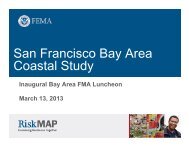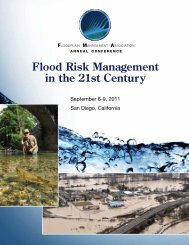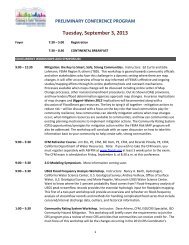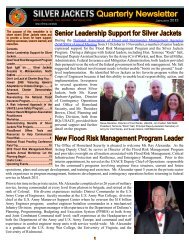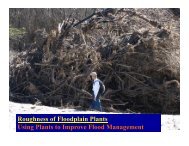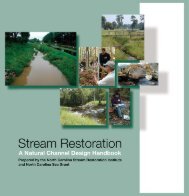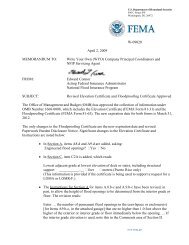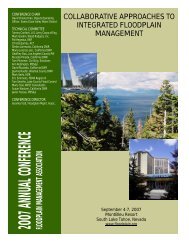Using Multi-Objective Management to Reduce Flood Losses in Your
Using Multi-Objective Management to Reduce Flood Losses in Your
Using Multi-Objective Management to Reduce Flood Losses in Your
Create successful ePaper yourself
Turn your PDF publications into a flip-book with our unique Google optimized e-Paper software.
How much time and effort is spent on collect<strong>in</strong>g data depends on the time<br />
and resources available. However, the plann<strong>in</strong>g process should not be delayed<br />
while wait<strong>in</strong>g for more data just so you can develop a highly detailed problem<br />
description. It’s more important <strong>to</strong> get mov<strong>in</strong>g.<br />
The problem description<br />
should <strong>in</strong>clude a map or maps of<br />
EXAMPLE FLOOD PROBLEM MAP<br />
the area of concern, which can be<br />
updated as more <strong>in</strong>formation<br />
comes <strong>in</strong>. It should also have a<br />
discussion of the impacts of<br />
flood<strong>in</strong>g. The follow<strong>in</strong>g should be<br />
mentioned:<br />
The number, types, and<br />
locations of build<strong>in</strong>gs<br />
affected by the base flood<br />
The type of damage<br />
expected (are the<br />
build<strong>in</strong>gs washed away or<br />
do they just get wet)<br />
Roads, bridges, and<br />
transportation facilities<br />
closed dur<strong>in</strong>g a flood<br />
Critical facilities affected<br />
(e.g., hospitals damaged<br />
or isolated)<br />
Areas of repetitive<br />
flood<strong>in</strong>g<br />
<strong>Flood</strong> protection measures<br />
<strong>in</strong> effect or under<br />
construction<br />
What happened <strong>in</strong> past floods<br />
Undeveloped areas and wetlands that can provide “natural and beneficial<br />
functions.”<br />
Other hazards<br />
A good plan should <strong>in</strong>tegrate consideration of other hazards besides flood<strong>in</strong>g.<br />
They can be natural hazards, such as hurricanes, earthquakes, <strong>to</strong>rnados, ice<br />
s<strong>to</strong>rms, drought, and wildfire; and “technological” hazards, such as releases from<br />
nuclear power plants and hazardous materials spills.<br />
Most of these hazards are not site specific. However, some technological<br />
hazard sites may be <strong>in</strong> the floodpla<strong>in</strong>. When they are flooded, the danger and<br />
damage caused by a flood is greatly <strong>in</strong>creased. The local and county emergency<br />
management office has more <strong>in</strong>formation on these hazards and what is be<strong>in</strong>g done<br />
<strong>to</strong> protect people from them.<br />
51



